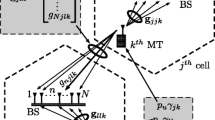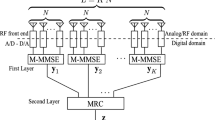Abstract
This paper evaluates a low-complexity Multiuser Adaptive Modulation (MAM) scheme for an uplink massive multiple-input and multiple-output (MIMO) systems with maximum-ratio combining (MRC) linear receivers, which requires only slow-varying large-scale shadowing information for the users. For a channel that includes both small-scale and large-scale fading, the probability density function of signal-to-interference-plus-noise ratio (SINR) is mathematically analyzed and verified by simulation. Furthermore, closed-form expressions are derived for the average spectral efficiency and bit error outage. Since the MRC is desirable in low transmit power, the obtained analytical expressions are approximated at low power levels. Moreover, the paper investigates different users’ arrangements around the base station to achieve the maximum possible bit rate. For MAM with joint power control, optimal power adaptation strategy switching thresholds are also acquired. Compared to the existing research literature, the proposed adaptive scheme by the MRC receiver gives similar performance as a proper adaptive method at low power transmission.








Similar content being viewed by others
References
Goldsmith, A. J., & Chua, S.-G. (1997). Variable-rate variable-power MQAM for fading channels. Transactions on Communications, 45(10), 1218–1230.
Chung, S. T., & Goldsmith, A. J. (2001). Degrees of freedom in adaptive modulation: A unified view. IEEE Transactions on Communications, 49(9), 1561–1571.
Chou, E. S., & Kahn, J. M. (2020). Adaptive coding and modulation for robust optical access networks. Journal of Lightwave Technology., 38, 8.
Elzanaty, A., & Alouini, M. S. (2020). Adaptive coded modulation for IM/DD free-space optical backhauling: A probabilistic shaping approach. IEEE Transactions on Communications., 68(10), 6388–6402.
Yang, P., Xiao, Y., Xiao, M., Guan, Y. L., Li, S., & Xiang, W. (2019). Adaptive spatial modulation MIMO based on machine learning. IEEE Journal on Selected Areas in Communications, 37(9), 2117–2131.
Su, W., Lin, J., Chen, K., Xiao, L., & En, C. (2019). Reinforcement learning based adaptive modulation and coding for efficient underwater communications. IEEE Access, 7, 67539–67550.
Lee, D., Sun, Y. G., Kim, S. H., Sim, I., Hwang, Y. M., Shin, Y., Kim, D. I., & Kim, J. Y. (2020). DQN-based adaptive modulation scheme over wireless communication channels. IEEE Communications Letters., 24(6), 1289–1293.
Xiaoling, Hu., Wang, J., & Zhong, C. (2020). Statistical CSI based design for intelligent reflecting surface assisted MISO systems. Springer.
Han, Y., Tang, W., Jin, S., Wen, C.-K., & Ma, X. (2019). Large intelligent surface-assisted wireless communication exploiting statistical CSI. IEEE Transactions on Vehicle Technology, 68(8), 8238–8242.
Conti, A., Win, M. Z., & Chiani, M. (2007). Slow adaptive M-QAM with diversity in fast fading and shadowing. IEEE Transactions on Communications, 55(5), 895–905.
Toni, L., & Conti, A. (2011). Does fast adaptive modulation always outperform slow adaptive modulation? IEEE Transactions on Wireless Communications, 55(5), 1504–1513.
Zhou, Y., & Zhong, C. (2016). A Low-Complexity Multiuser Adaptive Modulation Scheme for Massive MIMO Systems. IEEE signal processing letters, 23, 10.
Mihálykó, C., Blickle, T (2000) 84.48 on the approximation of the lognormal distribution, The Mathematical Gazette, vol. 84, no. 500, pp. 308–311, [Online]. Available: http://www.jstor.org/stable/3621676H.
Ngo, Q., (2015) Massive MIMO: Fundamentals and system designs, Ph.D. dissertation, Linköping Univ., Link Ãúping, Sweden
Li, T., Torlak, M., (2018) Performance of ZF linear equalizers for single carrier massive MIMO uplink systems, IEEE Access, vol. 6, pp. 32156_32172, 2018. [Online]. Available: https://ieeexplore.ieee. org/stamp/stamp.jsp?arnumberD8367816.
Zhang, C., Wu, Z., Studer, C., Zhang, Z., & You, X. (2018). Efficient soft-output Gauss-Seidel data detector for massive MIMO systems. IEEE Transactions on Circuits and Systems I: Regular Papers, 68, 5049.
Boukharouba, A., Dehemchi, M., & Bouhafer, A. (2021). Low-complexity signal detection and precoding algorithms for multiuser massive MIMO systems. SN Applied Sciences, 3(2), 1–7.
Jaiswal, G., Gudla, V. V., Kumaravelu, V. B., Reddy, G. R., & Murugadass, A. (2020). Modified spatial modulation and low complexity signal vector based minimum mean square error detection for MIMO systems under spatially correlated channels. Wireless Personal Communications, 110(2), 999–1020.
Beiranvand, J., & Meghdadi, H. (2018). Analytical performance evaluation of MRC receivers in massive MIMO systems. IEEE Access, 6, 53226.
Abdi, A., & Kaveh, M. (1999). On the utility of gamma PDF in modeling shadow fading (slow fading). In 1999 IEEE 49th Vehicular Technology Conference (Vol. 3, pp. 2308-2312). IEEE.
Alnajjar, K. A., Smith, P. J., & Woodward, G. K. (2015). Low complexity V-BLAST for massive MIMO with adaptive modulation and power control. In 2015 International Conference on Information and Communication Technology Research (ICTRC) (pp. 1–4).
Gradshteyn, I. S., Ryzhik, I. M. (2007) Table of Integrals, Series, and Products, 7th ed., A. Jeffrey and D. Zwillinger, Eds. NewYork, NY, USA: Academic.
Funding
I confirm that, this paper has no funding or financial support.
Author information
Authors and Affiliations
Corresponding author
Ethics declarations
Conflict of interest
The authors declare that they have no known competing financial interests or personal relationships that could have appeared to influence the work reported in this paper. The authors declare the following financial interests/personal relationships which may be considered as potential competing interests.
Data availability
Data sharing not applicable to this article as no datasets were generated or analyzed during the current study.
Code availability
I have implemented the equations that was provided in the paper by Matlab codes then validated them by simulation.
Additional information
Publisher's Note
Springer Nature remains neutral with regard to jurisdictional claims in published maps and institutional affiliations.
Appendices
Appendix A
1.1 Proof Theorem I
In this appendix, we evaluate the conditional PDF of SINR on \({\overline{\gamma }}_{k}\) for the channel state in case I.
Instantaneous SINR of user k for the channel state in case I will be as below:
Then:
where:
where in Eq. (46), \(T\) has a three-parameter (shifted) gamma distribution\(G\left(K-1 , 1 , \frac{M}{\overline{\gamma }}\right)\).
By Jacobian Method (\({\gamma }_{k}= \frac{\mathrm{X}}{\mathrm{T}}\), T = T;\({f}_{{\Upsilon}_{k} , T}\left({\gamma }_{k},t\right)={\left|\mathrm{J}\right|}^{-1} {f}_{X , T}\left(x,t\right)\)):
This integral can be solved using equation [22, (3.383–4)]:
where \({L}_{n}^{\alpha }\) is [22, (8.970.1)]:
where ρ \(=1-K\) (Fig. 9, 10, 11).
Appendix B
2.1 Proof Theorem 2
In this appendix, we evaluate the conditional PDF of SINR on \({\overline{\gamma }}_{k}\) for the channel state in case II.
Instantaneous SINR of user k for the channel state in case II will be as below:
As we know:
where the relation in (55) implies that \({z}_{ik}\) follows a \(K\)-distribution with the mean of \(a\theta\) and the first and second shape parameters, \(a\) and 1, respectively. Also, the definition of parameter \(\theta\) is as follows:
If we consider \(Z\) as the sum of \({z}_{ik}\) random variables, then:
It is proven in [23] that the sum of \(K\)- distributed random variables follows a \(K\)- distributed random variable with a different shape factor. Therefore, \(Z\sim {K}_{distribution }\left(\theta \left(K-1\right) a, a , K-1\right)\) and the distribution of random variable\(Z\):
Then, we assume \(T=pZ+1\). Therefore, \(T\) has a four-parameter (shifted) K-distribution,
\({K}_{distribution }\left(p\theta \left(K-1\right) a, a , K-1, 1\right)\) with PDF given by:
By Jacobian Method like previous part\((\Psi = \frac{\mathrm{X}}{\mathrm{T}} )\), we have:
If we put:
Then by changing of variable \({\varphi = (t-1 )}^\frac{1}{2}\) eventually, we have:
This integral is solved using equation [22, (6.631–3)]:
Finally, the PDF is as follows:

where:

Appendix C
3.1 Proof Theorem 3
In this appendix, we evaluate the conditional PDF of SINR on \({\overline{\gamma }}_{k}\) for the channel state in case III.
Reconsidering Eq. (52) for the channel state in case III, we have:
As we know:
where omitting index \(i\) in (69) can be asymptotically true only for a small number of users (\(K\)).
As we know:
By fixing \({\beta }_{i}\) and writing \({y}_{k}{ =z }_{ik}/{\beta }_{i}\), we obtain the conditional PDF \({f}_{{z }_{ik}|{y}_{k}}\left(z|y\right)\) as follows:
So, the distribution for the RV \({z }_{ik}\) can be described as:
Considering (72), each \({z }_{ik}\) can be viewed as a Gamma-distributed RV with shape parameter \(a\), and random scale parameter \({y\theta }_{i}\). It follows that given \({y}_{k}\), the RV \(Z\) in (58) is the sum of \(K-1\) independent gamma-distributed RVs with different second parameters. Finally, the PDF of \(Z\) conditioned on \({y}_{k}\) can be computed by Satterthwaite Procedure. This procedure is described in lemma 1.
Lemma 1: \(\frac{\nu U}{E\left\{U\right\}}\) has an approximate \({\chi }^{2}\) distribution with the following degree of freedom:
We can assume \({X}_{i}= {{a}_{i}U}_{i} \sim G({ K}_{i} , {\eta }_{i})\) where \({K}_{i}= {\nu }_{i}/2\) and \({\eta }_{i}=\) 2\({a}_{i}\).
Therefore, we have:
In our case, we replace \({K}_{i} with \ a\) for all \(i\), \({\eta }_{i}= {y\theta }_{i}\) and also \({X}_{i}\) with conditional \({z}_{ik}\) on \({y}_{k}\) so we have approximated conditional pdf for \(Z\) as bellow:
where:
So, the unconditional distribution of Z can be obtained by averaging the PDF over \({y}_{k}\), that is:
Again, following the step from (60) to (64), we have:
Rights and permissions
About this article
Cite this article
Radbord, A., Hafez, M.A. & Amini, M. Analysis of a Low Cost and Low Complexity Adaptive Transmission Scheme for Massive MIMO Systems with Interference. Wireless Pers Commun 126, 3569–3593 (2022). https://doi.org/10.1007/s11277-022-09879-5
Accepted:
Published:
Issue Date:
DOI: https://doi.org/10.1007/s11277-022-09879-5







